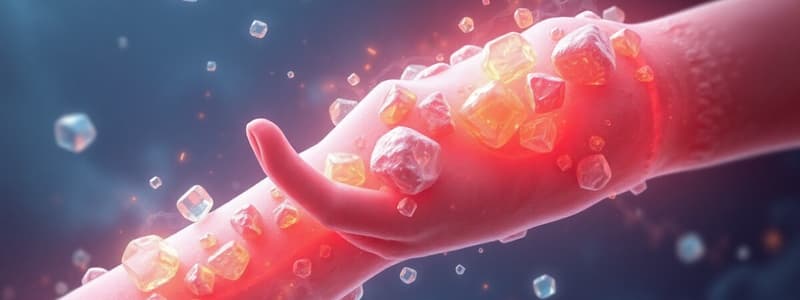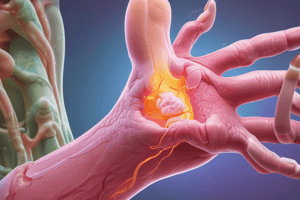Podcast
Questions and Answers
Gout is characterized by the deposition of which substance in tissues?
Gout is characterized by the deposition of which substance in tissues?
- Monosodium urate (MSU) (correct)
- Cholesterol
- Amyloid protein
- Calcium pyrophosphate dihydrate (CPPD)
Hyperuricemia, a key factor in the development of gout, can result from:
Hyperuricemia, a key factor in the development of gout, can result from:
- Increased renal excretion of uric acid.
- Promotion of urate crystal dissolution.
- Decreased production of uric acid.
- Excess uric acid production. (correct)
Which of the following is considered a stage of gout?
Which of the following is considered a stage of gout?
- Remission stage
- Regenerative phase
- Hypouricemic stage
- Intercritical gout (correct)
What is the approximate male to female ratio in gout?
What is the approximate male to female ratio in gout?
Which of the following comorbidities is least associated with gout?
Which of the following comorbidities is least associated with gout?
Which dietary factor is most associated with an increased risk of gout?
Which dietary factor is most associated with an increased risk of gout?
What is the typical time frame for maximum pain intensity during an acute gout flare?
What is the typical time frame for maximum pain intensity during an acute gout flare?
In what percentage of patients does the first metatarsophalangeal joint get involved (podagra) in gout?
In what percentage of patients does the first metatarsophalangeal joint get involved (podagra) in gout?
How long does an untreated acute gouty attack typically last?
How long does an untreated acute gouty attack typically last?
How long after initial acute intermittent gout does chronic tophaceous gout usually develop?
How long after initial acute intermittent gout does chronic tophaceous gout usually develop?
Which of the following best describes tophi?
Which of the following best describes tophi?
Definitive diagnosis of gout is achieved how?
Definitive diagnosis of gout is achieved how?
Which dietary recommendation is typically advised for patients with gout?
Which dietary recommendation is typically advised for patients with gout?
Which medication is used as a first-line therapy for acute gout?
Which medication is used as a first-line therapy for acute gout?
Which medication is utilized to inhibit microtubule polymerization and prevent neutrophil migration?
Which medication is utilized to inhibit microtubule polymerization and prevent neutrophil migration?
When should serum urate-lowering therapy (ULT) be initiated?
When should serum urate-lowering therapy (ULT) be initiated?
How often should serum urate levels be monitored when titrating a dose?
How often should serum urate levels be monitored when titrating a dose?
Allopurinol works by?
Allopurinol works by?
Among older adults, which medication should be avoided due to a greater risk of adversive effects?
Among older adults, which medication should be avoided due to a greater risk of adversive effects?
A patient with gout develops drug toxicity or displays intolerance. What action should be taken?
A patient with gout develops drug toxicity or displays intolerance. What action should be taken?
Flashcards
What is Gout?
What is Gout?
A systemic metabolic disease caused by tissue deposition of monosodium urate (MSU) due to prolonged hyperuricemia.
What is hyperuricemia?
What is hyperuricemia?
Elevated uric acid levels in the blood, which can lead to gout.
Asymptomatic hyperuricemia
Asymptomatic hyperuricemia
A condition where the patient has elevated uric acid but no symptoms.
Acute gouty flare
Acute gouty flare
Signup and view all the flashcards
Intercritical gout
Intercritical gout
Signup and view all the flashcards
Chronic tophaseous gout
Chronic tophaseous gout
Signup and view all the flashcards
Renal Insufficiency
Renal Insufficiency
Signup and view all the flashcards
Podagra
Podagra
Signup and view all the flashcards
Tophi
Tophi
Signup and view all the flashcards
Colchicine
Colchicine
Signup and view all the flashcards
Corticosteroids
Corticosteroids
Signup and view all the flashcards
Serum urate-lowering therapy (ULT)
Serum urate-lowering therapy (ULT)
Signup and view all the flashcards
Xanthine oxidase inhibitors
Xanthine oxidase inhibitors
Signup and view all the flashcards
Indomethacin
Indomethacin
Signup and view all the flashcards
Patient Education for Gout
Patient Education for Gout
Signup and view all the flashcards
Study Notes
- Gout is characterized by swollen and inflamed joints due to uric acid crystals.
Gout Description
- Gout is a systemic metabolic disease.
- A group of disease states caused by tissue deposition of monosodium urate (MSU) can lead to prolonged hyperuricemia.
- Hyperuricemia develops from excess uric acid production, decreased renal excretion, or both.
- Hyperuricemia types include primary and secondary.
- Gout has 4 stages: asymptomatic hyperuricemia, acute gouty flares, intercritical gout and chronic tophaceous gout.
Epidemiology
- Gout is the most common inflammatory arthritis in adults.
- Approximately 3.9% of adults in America have gouty arthritis.
- The prevalence of gout increases with age.
- Incidence of gout is increasing in most developed countries.
- The male to female ratio is about 4:1.
- Predominant age for gout is 30-50 in men and older than 60 in women.
Risk Factors
- 73% of gout patients have mild to severe renal insufficiency.
- Medications like diuretics, low-dose aspirin, tacrolimus, and cyclosporine can increase gout risk.
- Comorbidities associated with increased gout risk are obesity, renal disease, hypertension (HTN), and metabolic syndrome.
- High consumption of meat and seafood, overeating, and alcohol consumption in men are risk factors.
- Lower body temperature, trauma, surgery, dehydration, and starvation can increase gout risk.
Clinical Presentation: Acute Gout
- Acute gout involves rapid onset and buildup of pain, reaching maximum intensity within 4-12 hours.
- The first flare often begins at night.
- Symptoms include intense pain with warmth, redness, tenderness, swelling, and decreased range of motion (ROM) of the affected joint.
- The initial episode is usually monoarticular in men.
- In about 50% of patients, the first metatarsophalangeal joint is affected, known as podagra
- Other joints that can be affected are insteps, heels, knees, wrists, fingers, and elbows.
- May present systemic signs such as fatigue, fever, chills.
- Without treatment, acute gout can last from several hours to several weeks
Clinical Presentation: Chronic Tophaceous Gout
- Usually develops after 5-10 years of acute intermittent gout.
- It is characterized by collections of solid urate with chronic inflammatory and destructive changes in the connective tissue
- "Tophus" means "chalk stone” in Latin.
- Tophi appear as firm swellings; not painful or tender, and may reveal a yellow or white.
- Common sites include digits of the hands and feet, olecranon bursa, and helix and antihelix of the ear.
Diagnostic Evaluation
- A definitive diagnosis is achieved by needle aspiration.
- Lab tests include uric acid levels, CBC, and inflammatory markers.
- Musculoskeletal ultrasound may show a hyperechoic band over anechoic cartilage.
- Dual-energy computed tomography enables visualization of MSU crystal deposits; however, it has lower sensitivity in patients with recent-onset disease.
Lifestyle Recommendations
- Weight loss for obese patients to achieve a healthy BMI is recommended.
- A healthy diet and regular physical exercise, along with smoking cessation and staying well hydrated, can promote general health.
- Limit organ meats high in purine content (e.g., sweetbreads, liver, kidney), beef, lamb, pork, and seafood with high purine content (e.g., sardines, shellfish).
- High fructose corn syrup-sweetened sodas, naturally sweet fruit juices, table sugar/sweetened beverages/desserts, and table salt should be avoided.
- It is important to avoid alcohol overuse (defined as more than 2 servings per day for males and 1 serving per day for females), especially beer, in all gout patients.
- Low-fat or non-fat dairy products and vegetables are encouraged.
Pharmacologic Management of Acute Gout
- First-line therapy includes NSAIDs, any of which can be given at the maximal dosage and continued for one to two days after relief of symptoms (e.g., Indomethacin 50 mg three times per day).
- Colchicine prevents neutrophil migration and is more effective during the first 12-24 hours of an attack; avoid use in patients with renal and hepatic insufficiency; Colchicine 1.2 mg initially, then 0.6 mg one hour later, then 0.6 to 1.2 mg per day
- Corticosteroids are preferred for patients in whom NSAIDs and colchicine are contraindicated and should be tapered to avoid rebound flares.
- Oral, intramuscular, or intra-articular routes for administration with variable dosing: Prednisone, 40 mg for four days, then 20 mg for four days, then 10 mg for four days.
Chronic Gout Prevention
- Serum urate-lowering therapy (ULT) should be initiated to prevent recurrences in persons with a history of gout, at least two flares per year (or one per year in persons with chronic kidney disease stage 2 or greater), tophi, or nephrolithiasis.
- ULT should be started 6-8 weeks after the flare has resolved, starting at low doses and increasing every 4-6 weeks to reach a serum urate level of less than 6mg/dl.
- Normal serum urate levels do not exclude the diagnosis of gout.
- ULT should be continued for three to six months after a flare if there are no ongoing symptoms, but therapy should continue indefinitely if there are still ongoing signs or symptoms or tophi on examination.
Treatment of Chronic Gout
- Xanthine Oxidase Inhibitors (Uricostatic Drugs): Decrease uric acid synthesis
- Allopurinol (Zyloprim): 100 mg per day initially, however, with renal dysfunction, a common effective dosage is 300 mg per day, but higher dosages may be needed
- Febuxostat (Uloric): 40 mg once per day, may increase up to 80 mg per day if serum uric acid level is > 6 mg per dL (357 µmol per L) after two weeks
Geriatric Considerations
- Avoid loop and thiazide diuretics if they have HTN and gout because these agents can increase uric acid levels.
- Calcium channel blockers and the ARB Losartan are associated with a decreased risk of incident gout.
- Losartan is the only angiotensin receptor blocker with this property.
- Indomethacin is avoided in older adults because of the greater risk of adverse effects compared with other NSAIDs.
- Glucocorticoids are generally tolerated in short-term use for acute attacks in patients in whom NSAIDs or colchicine may pose an increased risk.
- Contraindications to the use of NSAIDs in older adults include the presence of heart failure, renal impairment, or gastrointestinal disease such as ulcers.
- Contraindications to colchicine include gastrointestinal intolerance, dosing restrictions in patients with renal and hepatic dysfunction, and potential drug interactions and also may include the high cost of therapy.
Referral indications
- Establish the diagnosis by joint aspiration and monosodium urate crystal identification
- Drug toxicity or if intolerance occurs
- If a patient still develops acute flares despite the maximum tolerated treatment
- If the diagnosis is in doubt
- If the patient is unable to use or tolerate the medication
Follow-up
- Acute gout: 1 week appointment
- Chronic gout: 2 month appointment
Patient Education
- Identification of characteristics crystals
- Education regarding medications: acute gout/to prevent further attacks/chronic gout
- Lifestyle changes: controlling weight, limiting alcohol, limiting meals with meats and fish rich in purines, increasing low-fat dairy consumption, and consuming cherries to control gout
- Patients with chronic gout will require lifetime treatment to lower the uric acid body pool
Studying That Suits You
Use AI to generate personalized quizzes and flashcards to suit your learning preferences.




